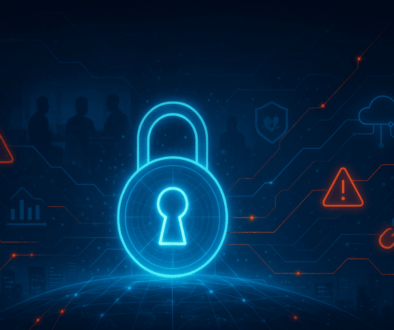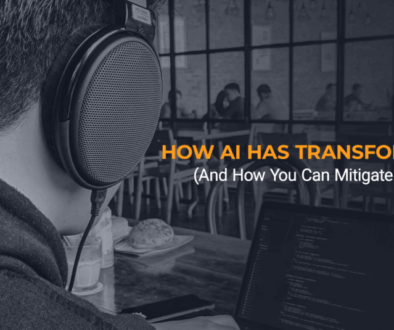AI-Driven Deception: How Hackers Use Generative AI for Social Engineering

Banner image generated by AI
Author: Marie Strawser, UMSA Managing Director
October 6, 2025
Generative AI — the tools that can write convincing emails, create realistic voices, and fabricate video — has opened a vast new opportunity for productivity. Unfortunately, it has also supercharged social engineering. Attackers are leveraging AI to automate, scale, and personalize attacks that previously required manual effort, creativity, and specialized skills. That means the human layer — the last line of defense — is now under attack from synthetic, yet highly believable, adversaries.
Keep reading to learn how criminals are weaponizing generative AI, see real-world attack patterns in action, and discover practical, employee-friendly steps your team can take right now to reduce risk.
Why generative AI matters to social engineers
Traditionally, social engineering relied on research, patience, and good writing. Generative AI shortens that cycle:
- Scale: What once required a few handcrafted phishing templates can now be produced in thousands of personalized variants in minutes.
- Personalization: AI can combine public data (LinkedIn, company bios, news) to craft messages tailored to an individual’s role, tone, and recent activities.
- Spear-phishing 2.0: Deepfakes — realistic voice or video impersonations — let attackers convincingly pose as executives, vendors, or customers.
- Speed: Attackers test and iterate messaging quickly, discovering which lures succeed and then automating the winning templates.
- Convincing writing: AI-generated text often uses natural phrasing and social cues that trick recipients into lowering their guard.
Put simply, AI replaces the minimum viable skill set previously required for high-impact social attacks.
Common AI-powered attack techniques
- Hyper-personalized phishing
AI assembles a target’s public info and generates an email that matches their work style and relationships — referencing specific projects, recent meetings, or even the names of co-workers. These emails look less like generic spam and more like real business communications.
An attacker uses a short audio sample to synthesize an executive’s voice and calls finance or HR, requesting urgent wire transfers or payroll changes. When combined with urgent language and a plausible context, this is very persuasive.
- Synthetic personas and social networks
AI builds fake LinkedIn profiles or email personas with realistic bios, endorsements, and posting history. These accounts are used to befriend employees, join groups, and gather trust — then deliver malicious links or requests.
- AI-assisted business email compromise (BEC)
Attackers automate the analysis of corporate email patterns and then craft messages that mimic internal workflows — e.g., an “FYI” from the CFO requesting a password reset link or payment instructions.
- Malicious file generation
AI can help create convincing attachments (contracts, invoices, memos) that carry malicious macros or prompt credential entry via realistic-looking portals.
Realistic scenarios
Imagine you get a Slack message from your manager: “Need the Q3 vendor payment approved — can you handle the wire? I’m in a meeting, send it now.” The message includes a link to a familiar invoicing portal. The tone, timing, and wording all match your manager. It’s easy to act before verifying.
Or an employee receives a voicemail from the CEO’s voice — urgent, terse, and asking for access to a shared drive. The voice is exactly how you remember it. That’s the danger of voice deepfakes.
These attacks aren’t science fiction — they prey on our reflex to help and our trust in colleagues’ communication styles.
How organizations can defend — practical controls
Technical controls
- Multi-factor authentication (MFA) everywhere, including privileged systems. MFA stops many unauthorized access attempts even if credentials are phished.
- E-mail authentication: enforce DMARC, DKIM, SPF with strict policies and monitor reports for anomalies.
- Outbound payment controls: require multi-person approval and out-of-band verification (e.g., phone call to a known number) for transfers above a threshold.
- Restrict macros and sandbox attachments: treat unusual file types as suspicious; use cloud-based document viewers that strip active content.
- Voice/biometric verification standards: build processes that don’t rely solely on voice recognition for approvals.
- Anti-deepfake tools: explore vendors and open-source tools that flag synthetic media — useful as an additional detection layer.
Process & policy
- Escalation protocols: require confirmation for sensitive requests via a second channel (phone call, known in-person contact, or a verified corporate directory lookup).
- Least privilege: limit permissions so attackers can’t immediately act on a single compromised account.
- Vendor and third-party validation: define and enforce how partners request payments and changes.
People & training
- Empathy-based phishing training: show real examples of AI-crafted messages and train employees to question emotional or urgent cues rather than simply training to click/not click.

- Report-first culture: make it easy and non-punitive for employees to report suspicious messages (dedicated Slack channel, 1-click report button in email client).
- Tabletop exercises: run drills that include AI-driven scenarios (voice deepfake, personalized spear-phish, fake vendor invoice).
- Security champions: embedded security-minded people inside teams who can act as quick consults
Incident response for AI-enabled attacks
- Contain quickly: isolate affected accounts, rotate credentials, and review logs for lateral movement.
- Preserve evidence: save the suspicious message, audio, or artifact for analysis; this helps identify AI models used and attacker TTPs.
- Notify impacted parties: communicate clearly with stakeholders (legal, communications, HR) to manage reputational risk.
- Remediate and adapt: after containment, adjust controls to address gaps exposed by the attack — e.g., add payment controls, improve MFA, or block IP ranges.
A short checklist for what to do today
- Enforce MFA and review privileged accounts.
- Add multi-person approval and out-of-band verification for payments.
- Update phishing training with real AI-driven examples.
- Audit vendor payment workflows and add verification steps.
- Run a tabletop exercise that includes a voice deepfake scenario.
- Make reporting suspicious messages frictionless and praised.
Closing: adapt people-first defenses
 Generative AI won’t go away — and neither will its misuse. The good news is that many of the strongest defenses are people-centered, featuring more transparent processes, better verification, and a culture that encourages skepticism when appropriate. Technology helps, but the real win comes from designing workflows and behaviors that assume deception is possible and make it costly and slow for attackers to succeed.
Generative AI won’t go away — and neither will its misuse. The good news is that many of the strongest defenses are people-centered, featuring more transparent processes, better verification, and a culture that encourages skepticism when appropriate. Technology helps, but the real win comes from designing workflows and behaviors that assume deception is possible and make it costly and slow for attackers to succeed.
Treat AI-driven social engineering like any other evolving risk: map where it intersects your critical business processes, harden those touchpoints first, and keep training real people to think critically. If you do that, you’ll make the new AI playground a lot less fun for attackers — and a lot safer for your organization.




